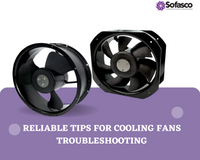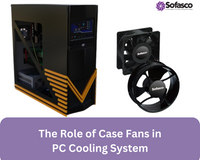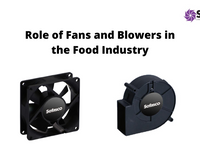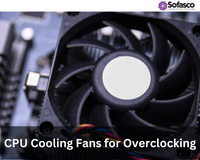Brushless DC motors remain a vital component in many modern electromechanical systems, from compact medical devices to rugged industrial cooling solutions. Their simple design, cost-effectiveness, and easy speed control make them an ideal choice across a wide range of applications. However, selecting the right brushed DC motor isn’t always straightforward. To ensure optimal performance, reliability and longevity, you need to evaluate several technical and environmental factors.
At Sofasco International, we’ve been engineering high-performance thermal management solutions, including axial fans, blowers, and chip coolers, for over four decades. Our products are used in high-humidity, high-temperature, and high-contamination environments where motor reliability is critical. This blog leverages our extensive engineering expertise to help OEMs, developers, and technical buyers make informed motor decisions.
Here are five key factors to consider when selecting a Brushless DC motor for your application.
1. Voltage Requirements
One of the first and most important steps is choosing the correct voltage rating for your motor. Brushed DC motors are commonly available in 6V, 12V, 24V, and higher, depending on the application. Selecting the wrong voltage can lead to poor efficiency or, worse, damage to the motor or control electronics.
For example, in our fan tray assemblies used in telecom enclosures, we often integrate 24V brushed DC motors to match the existing power infrastructure and ensure consistent airflow under continuous load.
Tip: Always check the compatibility of your power supply with the motor voltage to avoid performance issues or overheating.
2. Torque and Load Demands
Torque is the rotational force your motor can deliver. It’s crucial to evaluate both starting torque and continuous torque, especially if your application involves fluctuating or high startup loads.
In cooling fans used in avionics and medical devices, the load is relatively stable, but the motor must deliver consistent torque to maintain airflow even under thermal cycling. Under-sizing a motor for torque needs can result in stalling, premature wear, and thermal failure.
Pro Insight: Define your application's torque profile and ensure the motor is rated for peak and sustained loads to prevent breakdowns.
3. Speed (RPM)
Speed requirements vary depending on the use case. Brushless DC motors offer easy speed control through voltage variation, but selecting the correct RPM range is still vital.
In our high-speed axial fans, we often use Brushless motors designed for higher RPMs (e.g., 3000–6000 RPM) to maintain airflow in compact, heat-intensive environments like electronics enclosures or chip cooling systems.
Be mindful that higher speeds usually mean lower torque, and may require additional gearing or speed control modules depending on the duty.
4. Duty Cycle and Operating Time
Will the motor be running continuously or intermittently? Duty cycle refers to how long the motor operates in a given time period. For instance, a motor with a 25% duty cycle can run for 15 minutes every hour. If it exceeds that, it can overheat or degrade.
Our sleeve and ball bearing fan systems, used in data centers and telecom infrastructure, are often required to operate 24/7. That means we select motors with continuous duty ratings and robust thermal protection to ensure reliable operation over extended periods.
Always choose a motor designed for your system’s duty cycle. Continuous-duty motors typically come with better insulation, ventilation, and wear resistance.
5. Size and Mounting Constraints
Space limitations play a critical role in motor selection. You’ll need to factor in the motor’s physical size, shaft orientation, and mounting style.
At Sofasco™, our clients in the electronics and aerospace industries often require compact brushed DC motors that can be integrated into confined enclosures without compromising airflow or access. In such cases, we work closely with engineering teams to supply motors with the correct dimensions and mounting brackets, ensuring seamless system integration.
Pro Tip: Don’t forget to account for heat dissipation space and airflow paths during installation.
Choosing the right Brushless DC motor goes beyond just picking a size or speed. It requires a comprehensive understanding of your application’s electrical, mechanical, and environmental demands. At Sofasco™ International, we combine over 40 years of engineering expertise and supply chain integration to provide motor-driven cooling and airflow solutions that stand up to the most demanding conditions.
Whether you’re designing for telecom, medical, aviation, or electronics systems, our team can help you choose the right motor for optimal performance and lifecycle value.
Need Help Selecting the Right Motor or Fan Assembly?
We invite OEMs, engineers, and system integrators to connect with Sofasco™ International for expert advice and custom-engineered solutions.
Contact Us or explore our product catalog to find the perfect motor-driven fan for your next project.












